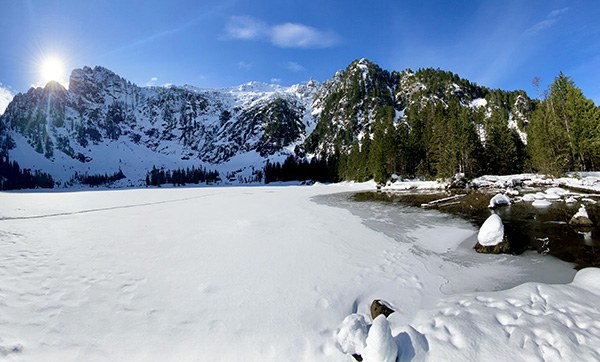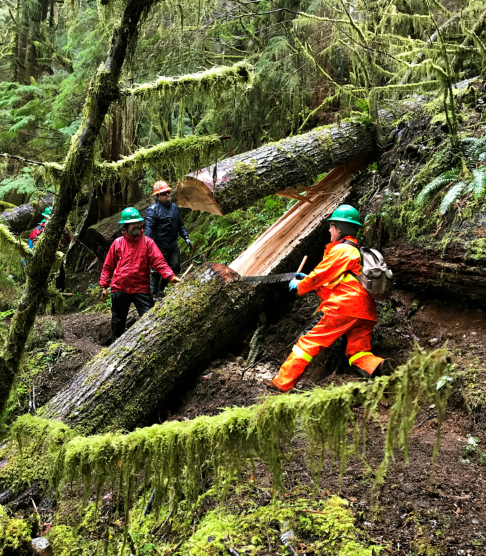
Let’s be honest: if our national parks and forests had a Yelp rating, it wouldn’t be five stars. Many of us encounter potholed roads, decrepit restrooms, and eroded trails all too often on our outdoor adventures. That’s why The Mountaineers has been fighting for years for better funding for our parks and public lands.
But every so often, years of advocacy, timing, and a little luck align to produce a special conservation win. Thanks to advocacy by Mountaineers members and the outdoor community, we’re finally receiving new resources to maintain trails, improve campgrounds, and repair roads, bridges, and facilities. The Great American Outdoors Act (GAOA) – which celebrated its first anniversary in August 2021 – is one of the latest examples of how a diverse coalition of outdoor advocates can come together to achieve historic investments for public lands in Washington and across the country.
There are two main components of this new law: much-needed resources to maintain and restore national parks and other federal public lands, and full and permanent funding for the Land and Water Conservation Fund (LWCF). These investments will make an impact across all communities for years to come, and it’s already started. The Mountaineers is committed to ensuring that these funds are directed towards priority projects in our region, and our conservation team has been tracking implementation of early GAOA projects. There’s a lot to be excited about in Washington.
Restoring what we have
More and more people visit our national parks and public lands each year, but Congress hasn’t kept up with enough funding to manage the impacts of increased use. Thanks to the Great American Outdoors Act, the National Parks and Public Lands Legacy fund provides $1.9 billion per year (for up to five years) for deferred maintenance and restoration of our national parks and other public lands. This won’t fund all the improvements needed, but five years of projects will make a huge difference.
National parks in Washington alone need more than $427 million in deferred maintenance. Through the National Parks and Public Lands Legacy Fund, federal land managers are already taking advantage of this new funding stream in order to address deferred maintenance needs in Washington. Here are some projects that are already under way in our local national parks and forests as a result of the first year of project funding:
Mount Rainier National Park
Mount Rainier National Park (MRNP) plays host to numerous Mountaineers activities and courses and occupies a special place in our organization’s history. MRNP was awarded $2.9 million to rehabilitate the Ohanapecosh campground and sewer collection lines, located among the old-growth forests in the southeast corner of the park. Park service staff were also able to capitalize on National Parks and Public Lands Legacy funding through the first year of GAOA to secure $27.7 million to complete the final phase of rehabilitation of nearly nine miles of Stevens Canyon Road, the sole east[1]west access across the park. These key improvements will go a long way toward enhancing the user experience in Washington’s most popular national park.
Olympic National Park
A project on the list for year two of GAOA funding will rehabilitate Olympic National Park’s Hurricane Ridge Day Lodge. The Hurricane Ridge area receives a high volume of visitors annually, and the lodge is the focal point of many visitors’ experience. These building improvements will protect the lodge from the elements, improve electrical systems, and bring the structure up to code.
Washington National Forests
Two region-wide deferred maintenance projects will bring 1,500 miles of priority trails in national forests throughout Washington and Oregon back to standard and replace 40 trail bridges. These funds will support key trail partners like Washington Trails Association as they implement these important trail improvements. Other region-wide projects will replace restrooms, picnic tables, and fire rings in high-visitation areas across the Mt. Baker-Snoqualmie, Okanogan[1]Wenatchee, and Gifford Pinchot National Forests.
Okanogan-Wenatchee and Mt. Baker-Snoqualmie
Over the next few years, you’ll likely see improvements to heavily-used recreation destinations in the Mt. Baker-Snoqualmie and Okanogan-Wenatchee National Forests. Popular trails and campgrounds in the I-90 corridor like the Snow Lake, Annette Lake, and Franklin Falls trails and the Tinkham, Kachess, and Wish Poosh campgrounds will receive some much-needed rehabilitation. Over on Mountain Loop Highway, hikers and picnickers will finally be able to access the Big Four Ice Caves over a new bridge, and the popular Heather Lake, Mt. Pilchuck, and Lake 22 trails are on the list to be improved in the coming years.
A permanent vision for land and water conservation
You’ve likely read how the Land and Water Conservation Fund (LWCF) is one of the most far-reaching and effective tools to conserve land and promote outdoor recreation. Over its more than 50 years, the program has positively impacted parks and public lands in every county and every state throughout the country. Yet despite its resounding success, Congress consistently funded LWCF at approximately half of its authorized funding level and didn’t permanently authorize the program until 2019.
The passage of the Great American Outdoors Act finally secured full and permanent funding for LWCF each year, dramatically increasing its impact on parks and public lands. Thanks to GAOA, the Evergreen State will receive more than double its previously allotted funding levels, which means more projects in Washington will be funded every year. Several local projects are already underway, including renovations to Maple Wood playground in Seattle, Sprinker Recreation Center near Tacoma, and Narrows Park in Gig Harbor.
LWCF is also a key tool to conserve natural landscapes from private development. This year, the Nature Conservancy is on the list to receive LWCF funding to permanently protect Taneum Creek and more than 12,000 acres in the Central Cascades near Cle Elum, promoting watershed health and preserving recreation access.
 Olympia branch volunteers clearing trail with WTA. Photo by Eileen Haydu.
Olympia branch volunteers clearing trail with WTA. Photo by Eileen Haydu.
Moving conservation forward
We’re thrilled that this new, dedicated funding is getting to work throughout the state’s public lands to enhance recreation opportunities and the visitor experience. However, these funds don’t erase the backlog of deferred maintenance projects. What’s more, the Forest Service currently lacks staff capacity to take full advantage of available funds. Since the 1990s, the number of non-fire Forest Service staff has been cut in half. That’s why we’re ramping up our efforts to advocate for increased appropriations for the Forest Service, so that they can better manage GAOA funding and other conservation priorities.
We’ve heard directly from lawmakers that community feedback on the local impacts of the Great American Outdoors Act is important for future funding considerations. Our Northwest congressional delegation knows how instrumental outdoor recreation is to public and economic health, our cultures, and our communities. They want to have an ongoing dialogue about how GAOA-funded projects and improvements impact your community and enhance our shared outdoor experience. If you can, we ask that you take the opportunity to thank them for their support of our state’s public lands and let them know how these important projects are making a difference.
As you’re out on the trail, consider the far-reaching impacts this funding will have on our region and our recreation, and how voices like yours helped make it a reality. Together, we can continue to build a compelling case for increased conservation funding to improve and protect treasured outdoor spaces throughout the region.
We’d love to hear from you: What local impacts are you seeing from LWCF and deferred maintenance projects? Share your story with us about how this important funding is making a difference in your community by emailing conservation@mountaineers.org.
This article originally appeared in our Winter 2022 issue of Mountaineer Magazine. To view the original article in magazine form and read more stories from our publication, visit our magazine archive.
 Conor Marshall
Conor Marshall